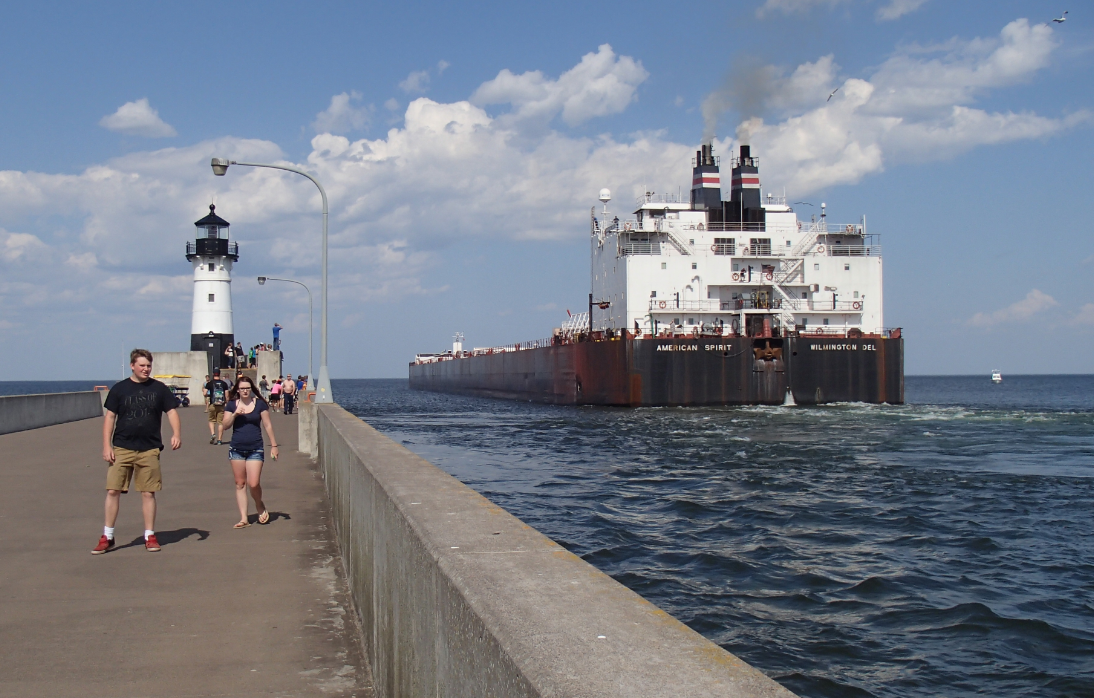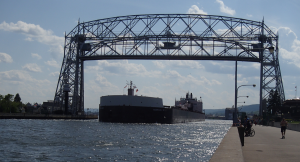
Just one minute after midnight on March 25, the first freighter began its journey through the Soo Locks at the tip of Michigan’s Upper Peninsula.
The 704-foot-long H. Lee White inaugurated what has already been a complicated 2020 Great Lakes shipping season: record high waters pushed back the opening of the St. Lawrence River to April 1, and now all ports, shipping companies and crew members are facing the COVID-19 virus.
Since the World Health Organization declared the dangerous virus a global pandemic on March 11, industries worldwide have worked to mitigate the spread of the disease and keep people safe. For Great Lakes shipping, workers are considered essential and therefore exempt from any state-mandated stay at home orders.
But that doesn’t mean they aren’t being impacted.
On March 13, the U.S. Coast Guard issued a safety bulletin requiring immediate notification if a crewmember contracts COVID-19.
Here’s more Great Lakes Now coverage of the shipping industry:


In preparation for the 2020 season, Steve Fisher, executive director of the American Great Lakes Port Association, has been working at the national level to keep information moving between various ports and the Centers for Disease Control and Prevention.
Luckily, dock workers and longshoremen don’t typically have much close contact with others while loading and unloading cargo. Many ships have automated unloading systems and port operators work from a control booth. Even when more direct handling is required, it’s often from the seat of a crane or forklift.
“In many instances the normal of cargo is not an activity that would be inconsistent with social distancing,” Fisher said.
It’s a different story for the sailors aboard freighters. While they are fully isolated from all other people during their weeks aboard the vessel, they do have close contact with one another.
Jim Weakley, president of the Lake Carriers’ Association, a trade group, said they’ve added extra precautions to keep everyone safe. Shift groups are being divided into even smaller units to mitigate the risk of a whole group falling ill, ship operating companies are pre-screening sailors for any signs of illness, and some ships are initiating a six-foot space between each person on the chow line, Weakley said.
Paperwork that would normally be exchanged between individuals on a vessel and port operators is all shifting to electronic communication so that fewer people will have direct contact with one another.
“We’re considering violations of guidelines as safety violations. We have a very strong safety culture, and safety includes good hygiene,” Weakley said.
Although many other industries have experienced a sharp decline in demand due to the ongoing quarantine orders, domestic shipping on the Great Lakes will continue humming along—at least for the start of the season.
Because the locks close over the winter, ports normally stock up on commodities like coal, iron ore and grains to make it through the winter. But those stockpiles will all be running low now, Weakley said, so ships are needed to transport goods around the Midwest.
On an average year, American vessels haul upwards of 90 million tons of cargo around the Great Lakes. Iron ore for steel production makes up the bulk of the cargo, followed by limestone and coal (for generating electricity). Sand, salt, cement, grain and gypsum account for another 6 percent of the annual total.
“Since 1775 the U.S.-flag Merchant Marine has always answered our nation’s call,” Weakley said. “The motto is ‘In peace and war,’ and sadly this situation kind of fits both.”
For now, the Great Lakes are still closed to international vessels that will be coming in from the St. Lawrence Seaway beginning on April 1. How the situation will evolve from there is largely unknown.
Daniel Abel, the Coast Guard’s deputy commandant for operations, testified before federal legislators that the cargo side of shipping has shown far less risk than cruise lines.
“Those [freight] ships come in and we restrict the crew to whatever it takes on the pier to turn the ship around. We have not seen a huge threat from cargo,” Abel said.
Whether the shipping industry in the Great Lakes will remain strong for the duration of the crisis is also an unanswerable question. The Port of Los Angeles (the largest container port in the U.S.) reported a 22.9 percent decrease in container volumes in February compared to a year ago and the American Association of Port Authorities predicted that first-quarter cargo volumes at U.S. ports could drop 20 percent due to supply chain disruptions, reports American Shipper.
Even if Great Lakes shipping is buffered from some of those effects by the need to stockpile goods for another winter at the end of the 2020 season, freight businesses could still feel the impact of an economic slowdown.
“The health of the shipping industry is dependent on the health of the steel industry, and that’s dependent on the auto industry,” Fisher said. “It all has a ripple effect.”
More COVID-19 coverage from Great Lakes Now:



Featured Image: The shipping channel where freighters enter and exit Duluth, Minn.’s port, Photo by Sandra Svoboda




